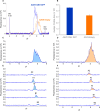Insights into Adeno-Associated Virus Capsid Charge Heterogeneity
- PMID: 40673772
- PMCID: PMC12355474
- DOI: 10.1021/acs.analchem.5c03104
Insights into Adeno-Associated Virus Capsid Charge Heterogeneity
Abstract
A comprehensive workflow is described to examine three contributing factors to the charge heterogeneity of Adeno-associated viruses (AAVs) from a single sample. Intact AAV9 capsids were fractionated using imaged capillary isoelectric focusing (icIEF)-based fractionation, allowing for collection of capsids with different isoelectric points (pIs). Capsid integrity of the fractions was confirmed with analytical icIEF and charge detection mass spectrometry (CD-MS). Using capillary electrophoresis (CE) immunoassays, the capsid protein ratios and capsid protein deamidation were characterized. Additionally, to analyze ssDNA content packaged in each fraction, CE-immunoassay and high-resolution CD-MS were used. This study enhances our understanding of AAVs, by examining the contributions of its attributes to capsid charge heterogeneity.
Figures





Similar articles
-
Characterizing the Content and Structure of AAV Capsids by Size Exclusion Chromatography and Orbitrap-Based Charge Detection-Mass Spectrometry.J Am Soc Mass Spectrom. 2025 Aug 6;36(8):1659-1668. doi: 10.1021/jasms.5c00074. Epub 2025 Jun 26. J Am Soc Mass Spectrom. 2025. PMID: 40568774 Free PMC article.
-
Enabling icIEF Peak Identification of AAV Capsid Proteins by Fractionation on MauriceFlex and Subsequent Analysis by LC-MS.Electrophoresis. 2025 Jan;46(1-2):22-33. doi: 10.1002/elps.202400201. Epub 2025 Jan 20. Electrophoresis. 2025. PMID: 39831456 Free PMC article.
-
Electrophoresis.2025 Jul 14. In: StatPearls [Internet]. Treasure Island (FL): StatPearls Publishing; 2025 Jan–. 2025 Jul 14. In: StatPearls [Internet]. Treasure Island (FL): StatPearls Publishing; 2025 Jan–. PMID: 36251838 Free Books & Documents.
-
Structural Capsidomics of Single-Stranded DNA Viruses.Viruses. 2025 Feb 27;17(3):333. doi: 10.3390/v17030333. Viruses. 2025. PMID: 40143263 Free PMC article. Review.
-
The effect of sample site and collection procedure on identification of SARS-CoV-2 infection.Cochrane Database Syst Rev. 2024 Dec 16;12(12):CD014780. doi: 10.1002/14651858.CD014780. Cochrane Database Syst Rev. 2024. PMID: 39679851 Free PMC article.
References
MeSH terms
Substances
LinkOut - more resources
Full Text Sources

